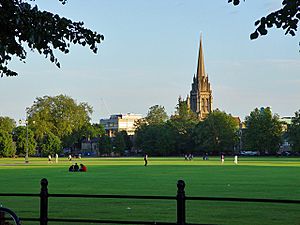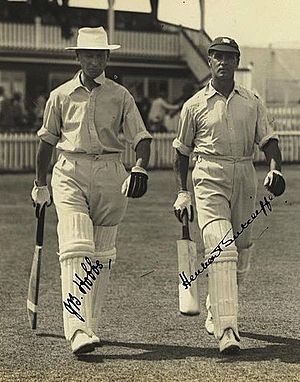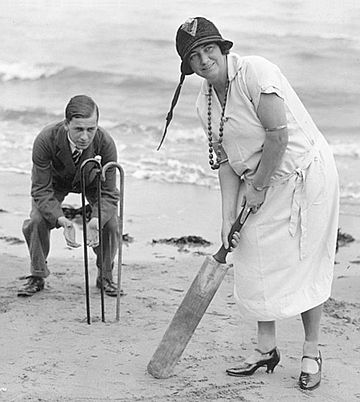Jack Hobbs facts for kids

Hobbs in about 1920
|
||||||||||||||||||||||||||||||||||||||||
| Personal information | ||||||||||||||||||||||||||||||||||||||||
|---|---|---|---|---|---|---|---|---|---|---|---|---|---|---|---|---|---|---|---|---|---|---|---|---|---|---|---|---|---|---|---|---|---|---|---|---|---|---|---|---|
| Full name |
John Berry Hobbs
|
|||||||||||||||||||||||||||||||||||||||
| Born | 16 December 1882 Cambridge, England |
|||||||||||||||||||||||||||||||||||||||
| Died | 21 December 1963 (aged 81) Hove, East Sussex, England |
|||||||||||||||||||||||||||||||||||||||
| Nickname | The Master | |||||||||||||||||||||||||||||||||||||||
| Batting | Right-handed | |||||||||||||||||||||||||||||||||||||||
| Bowling | Right-arm medium | |||||||||||||||||||||||||||||||||||||||
| Role | Opening batsman | |||||||||||||||||||||||||||||||||||||||
| International information | ||||||||||||||||||||||||||||||||||||||||
| National side | ||||||||||||||||||||||||||||||||||||||||
| Test debut (cap 157) | 1 January 1908 v Australia | |||||||||||||||||||||||||||||||||||||||
| Last Test | 16 August 1930 v Australia | |||||||||||||||||||||||||||||||||||||||
| Domestic team information | ||||||||||||||||||||||||||||||||||||||||
| Years | Team | |||||||||||||||||||||||||||||||||||||||
| 1905–1934 | Surrey | |||||||||||||||||||||||||||||||||||||||
| Career statistics | ||||||||||||||||||||||||||||||||||||||||
|
||||||||||||||||||||||||||||||||||||||||
Jack Hobbs (Sir John Berry Hobbs, 16 December 1882 – 21 December 1963) was a famous English professional cricket player. He is known as one of the greatest batsmen in cricket history. He holds records for the most runs and centuries in first-class cricket.
Contents
Early Life and Cricket Dreams

Jack Hobbs was born in Cambridge, England, on December 16, 1882. He was the first of 12 children. His family didn't have much money. Jack's father loved cricket and became a professional player. In 1889, he became the groundsman (who looks after the cricket field) and umpire at Jesus College.
From a young age, Jack played cricket whenever he could. He started playing in the streets near his home. He went to a local primary school. Later, he moved to York Street Boys' School. Jack said he wasn't a great student but was good at sports. He played cricket for his school team and helped his father at Jesus College during holidays. To help his family, Jack worked before school cleaning houses.
Starting His Cricket Career
After leaving school in 1895, Jack worked as an errand boy. His father's friends helped him get a summer job at the college. He mostly helped the cricket team. At 16, Jack became an apprentice gas fitter. In his free time, he practiced cricket on Parker's Piece, a big open field in Cambridge. He played for local clubs but didn't stand out much at first.
Jack's big chance came in 1901. His batting got much better that season. He scored 102 runs in one game, which was his first century. At the end of the season, he was chosen for a special Cambridge team. This team played against professional cricketers. Jack didn't do amazing, but he was invited to play as an amateur for Cambridgeshire.
In 1902, Jack became an assistant cricket coach at Bedford School. He helped prepare the fields and bowled in practice. Later that year, he played as a professional for the first time. He scored 119 runs for a team from Royston. This made him a local hero. A week later, his father sadly passed away from pneumonia. This left his family in a tough spot financially.
A friend of his father, Francis Hutt, helped Jack. He asked Surrey to give Jack a tryout. Jack impressed them. In the winter of 1902–03, Jack took over his father's job as groundsman at Jesus College.
Becoming a Professional Star
Jack Hobbs played for Surrey from 1905 to 1934. He also played for England in 61 Test matches between 1908 and 1930. People called him "The Master" because he was so good. Many experts believe he is one of the best batsmen ever. He holds the record for the most runs (61,760) and centuries (199) in first-class cricket.
Jack was a right-handed batsman. He sometimes bowled with his right arm at medium speed. He was also an excellent fielder, especially in the cover point position.
His reputation grew quickly. When he officially joined Surrey, he scored 88 runs in his first big game. In his very next game, he scored a century!
By 1907–08, Jack was playing Test cricket for England. He scored 83 runs in his first Test match. His international career lasted until 1930. After some ups and downs, he did very well against South African bowlers. This made his spot on the team secure. In 1911–12, he scored three centuries against Australia. After this, he was seen as the best batsman in the world until the mid-1920s.
In county cricket, Jack played with an exciting, attacking style. He scored runs quickly. He was very successful before the First World War. After the war, he again did well against Australia. However, his career was almost stopped by appendicitis in 1921. He missed most of that season. When he came back, he played more carefully. He focused on safer, more defensive shots. But he still continued to be very successful in both Test and domestic cricket. He stopped playing Tests in 1930 but continued with Surrey until 1934.

Jack was an opening batsman. This means he was one of the first two players to bat. He had great partnerships with other players. These included Tom Hayward and Andy Sandham for Surrey. For England, he partnered with Wilfred Rhodes and Herbert Sutcliffe. His partnership with Sutcliffe was the best in Test history. Cricket experts still consider Jack Hobbs one of the greatest batsmen of all time.
Life After Cricket
After he stopped playing cricket in 1934, Jack Hobbs became a journalist. He wrote four books in the 1930s that sold very well. He also had two autobiographies written for him. He preferred to stay out of the spotlight and avoided arguments. He continued to work at his sports shop.
During the Second World War, Jack served in the Home Guard. This was a defense organization in the UK. In 1946, he became the first professional player to be chosen for the Surrey cricket committee.
In 1953, Jack Hobbs was made a knight. This was a huge honor, and he was the first professional cricketer to receive it. He didn't want to accept it at first. But he agreed when he realized it was an honor for all professional cricketers, not just him. He stayed active into the 1960s, still working in his shop.
Family Life
In 1900, Jack met Ada Ellen Gates at a church service. They got married on September 26, 1906. Jack didn't like being away from his wife when he traveled for cricket. So, in later years, Ada often went with him on tours overseas. They had four children: Jack, Leonard, Vera, and Ivor.
How He Played
Cricket experts thought Jack Hobbs had a perfect batting style. He was successful because he moved his feet quickly. He could play many different types of shots. He was also very good at hitting the ball exactly where he wanted it to go. His amazing skills allowed him to play well even when he was older. He was especially good at batting on difficult pitches.
His Legacy
Jack Hobbs was chosen as Wisden's Cricketer of the Year twice, in 1909 and 1926. Only one other player has received this award twice. In 2000, a group of experts picked him as one of the five Wisden cricketers of the 20th century. In 2009, he was chosen for England's best-ever team. He was also included in a team representing the best players worldwide in cricket history.
His Test batting average of 56.94 is still one of the best for batsmen who have scored over 5,000 runs. He was the top Test run-scorer during his career. He also had the most Test runs when he retired.
People who knew Jack Hobbs said he was humble and kind. He never criticized other players. He tried to avoid arguments and didn't like too much attention.
Images for kids
-
Hobbs (right) opening the batting with Tom Hayward during the County Championship match between Surrey and Warwickshire at the Oval on 2 May 1910








